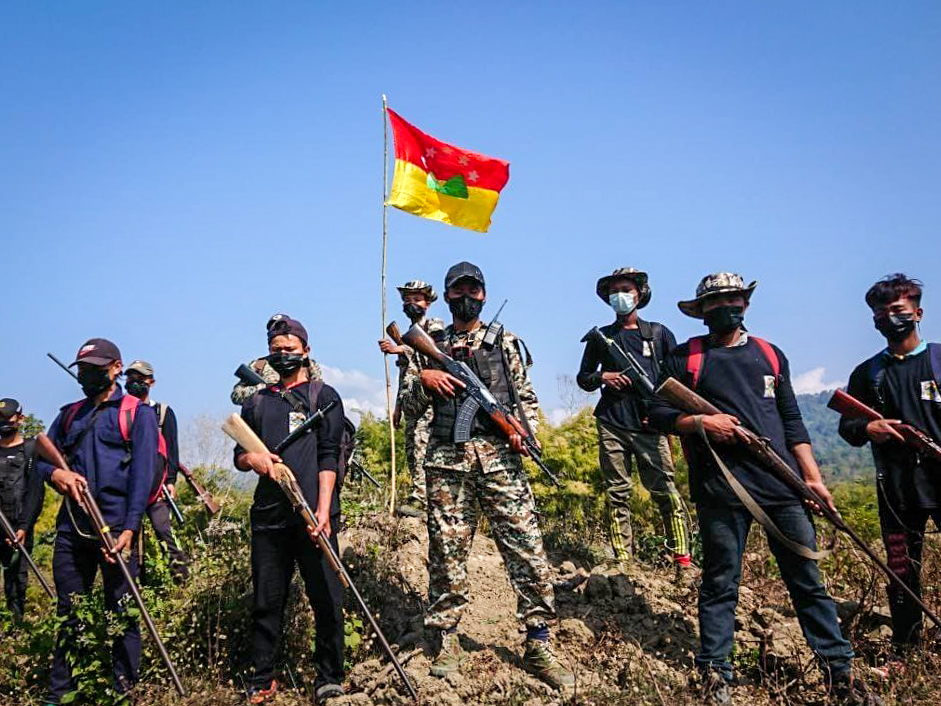Fighting has been raging for more than four months in Kyindwe, a remote town in Chin State’s Kanpetlet Township where resistance forces unleashed an onslaught on junta positions late last year.
The Chin Brotherhood, a military alliance of six ethnic Chin resistance groups, announced on Wednesday that it had seized the town.
Ethnic Chin resistance and People’s Defense Force (PDF) groups launched the offensive in December. The Chin Brotherhood and resistance forces from neighboring Magwe joined the offensive on March 7 and stepped up the attacks with assistance from the Arakan Army (AA). The town fell on Monday, according to reports.
The Chin Brotherhood includes the Zomi Federal Union, Chin National Organization, Chin National Council in Mindat, Maraland Territorial Council, and Chinland Defense Forces in Kanpetlet and Matupi.
Why is Kyindwe important?
Located in the Chin Hills of the Arakan Mountains, Kyindwe is a remote and undeveloped town. It has neither jade mines that enrich Kachin State’s Hpakant nor the bustling border trade of Karen State’s Myawaddy. Also absent is the booming development of a scam hub like Laukkai in northern Shan State.
Instead, Kyindwe is a sparsely populated backwater miles from any urban center.

So, why have junta and anti-regime forces battled to control the town for more than four months?
The answer lies in its strategic location.
Kyindwe was upgraded from a village in December 2018 and officially designated as a town in a ceremony in April 2019.
It is located in the southernmost part of Chin State and bordered by Rakhine State to the west and south. There is no direct road linking Kyindwe with Rakhine, but the Lemro (Lemyo) River just west of Kyindwe flows to the ancient Arakanese capital of Mrauk-U, which is under AA control.
Since launching its offensive last November, the AA has also taken seven more of Rakhine’s 18 townships, plus Paletwa in southern Chin State. The ethnic army’s stated aim is to take control of the whole state and form an independent administration.

Kyindwe’s only road links are to Chin State’s Kanpetlet and Laungshae in Magwe’s Saw Township. This means that whoever has control over Kyindwe has access to the resistance stronghold of Yaw region comprising Gangaw, Htilin and Saw townships in Magwe; Chin State’s hotspot of armed rebellion, Mindat and Kanpetlet; and the Lemro River to Mrauk-U, about 50 miles to the southwest as the crow flies.
Moreover, there are ordnance factories and banknote printing plants in Laungshae and Seikphyu, east of Kyindwe.
The town thus provides an ideal stronghold for combined anti-regime forces from Chin, Magwe and Rakhine.
This explains why the regime fought so desperately to keep it.

The junta has deployed airstrikes and 500 reinforcements to defend Kyindwe since December, according to Chin resistance groups, who added that both sides have suffered heavy losses.
The scale of the operation demonstrates the degree of importance the regime attaches to Kyindwe. By contrast, there was no corresponding airlift of hundreds of reinforcements when its Infantry Battalion 275 was attacked in the country’s largest border trade hub of Myawaddy last month.
The fall of Kyindwe therefore heralds the rise of resistance control over territory stretching from Mrauk-U to the Chin Hills and Yaw region to the east of the Pontaung and Ponnya mountains.
Moe Set Nyein Chan is a military analyst.
















